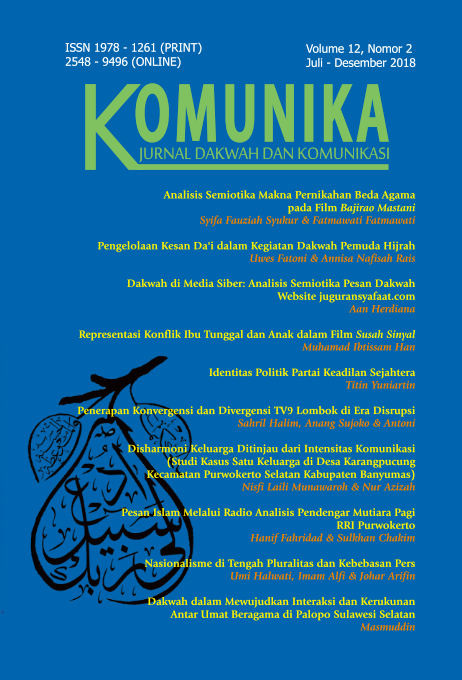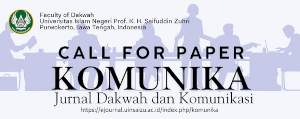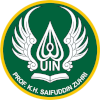Dakwah dalam Mewujudkan Interaksi dan Kerukunan Antar Umat Beragama Di Palopo Sulawesi Selatan
DOI:
https://doi.org/10.24090/komunika.v12i2.1681Keywords:
Interaksi Dakwah, ToleransiAbstract
Da’wah is carried out to spread the teachings of religion where humans as human beings choose religion according to their respective beliefs, but the reality that is seen now is that religion becomes a commodity and even a source of conflict. a lot of misunderstandings between religious people so that the harmony between religious groups can be realized well. Da’wah is done to increase understanding for followers of religion and society, this is also done as a preventive trap from the inclusion of an incorrect understanding of religion. Missionary mission is carried out to explain the teachings of the religion which he believes with the aim that other people can understand the teachings of religion through preaching delivered and can be implemented in daily life. Palopo is one of the administrative cities in the region of South Sulawesi, and the people of Palopo are Muslims, Christians, Catholics, Protestants, Hindus, Buddhists, and Confucians. The difference in religious beliefs in the Palopo community is expected to provide positive interactions so that there are harmonious communication and interaction as well as harmony between the religious community and their followers.Downloads
Download data is not yet available.
References
Affandi, N. (2012). Harmoni dalam Keragaman (Sebuah Analisis tentang Konstruksi Perdamaian Antar Umat Beragama). Lentera, XV(1), 77–84.
Aghsari, D., Wekke, I. S., & Abbas, N. (2017). Harmony of Coastal Community Regarding Its Ethnic Religion and Cultural Diversity. IOP Conference Series: Earth and Environmental Science. https://doi.org/10.1088/1755-1315/156/1/012034
Arifin. (2004). Psikologi Dakwah suatu pengantar studi (VI). Jakarta: PT Bumi Aksara.
Arifin, B. (2016). Implikasi Prinsip Tasamuh (Toleransi) dalam Interaksi antar Umat Beragama. Fikri: Jurnal Agama, Sosial Dan Budaya, Institut Agama Islam Ma’arif NU Metro Lampung, 1(2). Retrieved from http://journal.iaimnumetrolampung.ac.id/index.php/jf/article/view/20
Arifuddin, A. (2013). Sosiologi Dakwah. Bandung: PT Remaja Rosdakarya.
AS, E., & Aliyuddin. (2009). Dasar-Dasar Ilmu Dakwah: Pendekatan Filosofis dan Praktis. Bandung: Widya Padjadjaran.
Aziz, M. A. (2012). Ilmu Dakwah (Revisi Cet). Jakarta: Kencana.
Badan Litbang dan Diklat. (2013). Survey Nasional Kerukunan Umat Beragama. (H. A. Ahmad, Ed.). Jakarta: Badan Litbang dan Diklat Puslitbang Kehidupan Keagamaan Kementerian Agama RI.
BM, S. A. (2014). Konflik Sosial dalam Hubungan antar Umat Beragama. Jurnal Dakwah Tabligh, 15(2). https://doi.org/https://doi.org/10.24252/jdt.v15i2.348
Bungin, B. (2008). Sosiologi Komunikasi Teori, Paradigma, dan Diskursus Teknologi Komunikasi di Masyarakat (III). Jakarta: Kencana Prenadamedia Group.
Cangara, H. (2011). Komunikasi Politik: Konsep, Teori dan Strategi (III). Jakarta: PT Raja Grafindo Persada.
Cappellen, V., Patty, Saroglou, & Vassilis. (2012). Awe activates religious and spiritual feelings and behavioral intentions. Psychology of Religion and Spirituality, American Psychological Association, 4(3), 223–236.
Clobert, M., Saroglou, V., Hwang, K.-K., & Soong, W.-L. (2014). East Asian Religious Tolerance—A Myth or a Reality? Empirical Investigations of Religious Prejudice in East Asian Societies. Journal of Cross-Cultural Psychology, 45(10). https://doi.org/https://doi.org/10.1177/0022022114546641
Effendy, O. U. (2006). Komunikasi Teori dan Praktek. Bandung: Remaja Rosdakarya.
Gerungan, W. A. (1980). Psyhologi-Sosial Suatu Ringkasan. Bandung: Eresco.
Haryanto, J. T. (2013). Kontribusi Ungkapan Tradisional dalam Membangun Kerukunan Beragama. Walisongo: Jurnal Penelitian Sosial Keagamaan, 21(2). Retrieved from http://www.journal.walisongo.ac.id/index.php/walisongo/article/view/250
Hasim, H. (2016). Flow di Era Sosmed: Efek Dasyat Mengikat Makna. Bandung: PT Mizan Pustaka.
Ilaihi, W. (2010). Komunikasi Dakwah (1st ed.). Bandung: PT Remaja Rosdakarya.
Jumantoro, T. (2001). Psikologi Dakwah dengan aspek-aspek kejiwaan yang Qur’ani (1st ed.). Wonosobo: Amzah.
Madjid, N. (1993). Nurcholis Madjid, “Beberapa Renungan Tentang Kehidupan Keagamaan untuk Generasi Mendatang. Jurnal Ulumul Qur’an, 1(IV), 4.
Masykur. (2009). Pola Komunikasi Antar Umat Beragama. In Makalah Annual Conference Departemen Agama (p. 1). Jakarta: Departemen Agama.
Muhdina, D. (2015). Kerukunan Umat Beragama berbasis kearifan lokal di Kota Makassar. Jurnal Diskursus Islam, 3(1), 20–36. Retrieved from http://journal.uin-alauddin.ac.id/index.php/diskursus_islam/article/view/193
Nata, A. (2001). Peta Keragaman Pemikiran Islam di Indonesia. Jakarta: PT Raja Grafindo Persada.
Nisvilyah, L. (2013). Toleransi Antarumat Beragama dalam Memperkokoh Persatuan dan Kesatuan Bangsa (Studi Kasus Umat Islam dan Kristen Dusun Segaran Kecamatan Dlanggu Kabupaten Mojokerto). Jurnal Mahasiswa: Kajian Moral Dan Kewarganegaraan Universitas Negeri Surabaya, 2(1). Retrieved from http://jurnalmahasiswa.unesa.ac.id/index.php/jurnal-pendidikan-kewarganegaraa/article/view/2657
Pawiloy, S. (2002). Ringkasan Sejarah Luwu. Makassar: CV Telaga Zamzam.
Pimay, A. (2005). Paradigma Dakwah Humanis (1st ed.). Semarang: RaSAIL.
Sasono, A., Hafidhuddin, D., & Saefuddin, A. M. (1998). Solusi Islam atas Problematika Umat (1st ed.). Jakarta: Gema Insani Press.
Schjoedt, U., Sørensen, J., Nielbo, K. L., Xygalatas, D., Mitkidis, P., & Bulbulia, J. (2013). Cognitive Resource Depletion in Religious Interactions. Journal Religion, Brain & Behavior, 3(1). Retrieved from https://www.tandfonline.com/doi/abs/10.1080/2153599X.2012.736714
Shihab, A. (1998). Islam Inklusif Menuju Sikap Terbuka dalam Beragama (IV). Bandung: PT Mizan Pustaka.
Shihab, M. Q. (1992). Membumikan al-Quran (III). Bandung: Mizan.
Soekanto, S. (2007). Sosiologi suatu pengantar. Jakarta: PT Grafindo Persada.
Stavrova, O., Fetchenhauer, D., & Schlössera, T. (2013). Why are religious people happy? The effect of the social norm of religiosity across countries. Social Science Research, 43(1), 90–105. https://doi.org/https://doi.org/10.1016/j.ssresearch.2012.07.002
Sumbulah, U. (2015). Pluralisme dan Kerukunan Umat Beragama Perspektif Elite Agama di Kota Malang. Analisa Journal of Social and Religion, 22(01), 1–13. Retrieved from http://oaji.net/articles/2015/2111-1436158066.pdf
Suryana, T. (2011). Konsep dan Aktualisasi Kerukunan antar Umat Beragama. Jurnal Pendidikan Islam Ta’lim, 9(2), 127–136. Retrieved from http://jurnal.upi.edu/file/03_KONSEP_DAN_AKTUALISASI_KERUKUNAN_ANTAR_UMAT_BERAGAMA_-_TOTO.pdf
Syani, A. (1994). Sosiologi Skematika, teori dan terapan (1st ed.). Jakarta: PT Bumi Aksara.
Tasmara, T. (2000). Menuju Muslim Kaffah: Menggali Potensi Diri (1st ed.). Jakarta: Gema Insani Press.
Widjaja, H. A. W. (2010). Komunikasi dan Hubungan Masyarakat (VI). Jakarta: PT Bumi Aksara.
Aghsari, D., Wekke, I. S., & Abbas, N. (2017). Harmony of Coastal Community Regarding Its Ethnic Religion and Cultural Diversity. IOP Conference Series: Earth and Environmental Science. https://doi.org/10.1088/1755-1315/156/1/012034
Arifin. (2004). Psikologi Dakwah suatu pengantar studi (VI). Jakarta: PT Bumi Aksara.
Arifin, B. (2016). Implikasi Prinsip Tasamuh (Toleransi) dalam Interaksi antar Umat Beragama. Fikri: Jurnal Agama, Sosial Dan Budaya, Institut Agama Islam Ma’arif NU Metro Lampung, 1(2). Retrieved from http://journal.iaimnumetrolampung.ac.id/index.php/jf/article/view/20
Arifuddin, A. (2013). Sosiologi Dakwah. Bandung: PT Remaja Rosdakarya.
AS, E., & Aliyuddin. (2009). Dasar-Dasar Ilmu Dakwah: Pendekatan Filosofis dan Praktis. Bandung: Widya Padjadjaran.
Aziz, M. A. (2012). Ilmu Dakwah (Revisi Cet). Jakarta: Kencana.
Badan Litbang dan Diklat. (2013). Survey Nasional Kerukunan Umat Beragama. (H. A. Ahmad, Ed.). Jakarta: Badan Litbang dan Diklat Puslitbang Kehidupan Keagamaan Kementerian Agama RI.
BM, S. A. (2014). Konflik Sosial dalam Hubungan antar Umat Beragama. Jurnal Dakwah Tabligh, 15(2). https://doi.org/https://doi.org/10.24252/jdt.v15i2.348
Bungin, B. (2008). Sosiologi Komunikasi Teori, Paradigma, dan Diskursus Teknologi Komunikasi di Masyarakat (III). Jakarta: Kencana Prenadamedia Group.
Cangara, H. (2011). Komunikasi Politik: Konsep, Teori dan Strategi (III). Jakarta: PT Raja Grafindo Persada.
Cappellen, V., Patty, Saroglou, & Vassilis. (2012). Awe activates religious and spiritual feelings and behavioral intentions. Psychology of Religion and Spirituality, American Psychological Association, 4(3), 223–236.
Clobert, M., Saroglou, V., Hwang, K.-K., & Soong, W.-L. (2014). East Asian Religious Tolerance—A Myth or a Reality? Empirical Investigations of Religious Prejudice in East Asian Societies. Journal of Cross-Cultural Psychology, 45(10). https://doi.org/https://doi.org/10.1177/0022022114546641
Effendy, O. U. (2006). Komunikasi Teori dan Praktek. Bandung: Remaja Rosdakarya.
Gerungan, W. A. (1980). Psyhologi-Sosial Suatu Ringkasan. Bandung: Eresco.
Haryanto, J. T. (2013). Kontribusi Ungkapan Tradisional dalam Membangun Kerukunan Beragama. Walisongo: Jurnal Penelitian Sosial Keagamaan, 21(2). Retrieved from http://www.journal.walisongo.ac.id/index.php/walisongo/article/view/250
Hasim, H. (2016). Flow di Era Sosmed: Efek Dasyat Mengikat Makna. Bandung: PT Mizan Pustaka.
Ilaihi, W. (2010). Komunikasi Dakwah (1st ed.). Bandung: PT Remaja Rosdakarya.
Jumantoro, T. (2001). Psikologi Dakwah dengan aspek-aspek kejiwaan yang Qur’ani (1st ed.). Wonosobo: Amzah.
Madjid, N. (1993). Nurcholis Madjid, “Beberapa Renungan Tentang Kehidupan Keagamaan untuk Generasi Mendatang. Jurnal Ulumul Qur’an, 1(IV), 4.
Masykur. (2009). Pola Komunikasi Antar Umat Beragama. In Makalah Annual Conference Departemen Agama (p. 1). Jakarta: Departemen Agama.
Muhdina, D. (2015). Kerukunan Umat Beragama berbasis kearifan lokal di Kota Makassar. Jurnal Diskursus Islam, 3(1), 20–36. Retrieved from http://journal.uin-alauddin.ac.id/index.php/diskursus_islam/article/view/193
Nata, A. (2001). Peta Keragaman Pemikiran Islam di Indonesia. Jakarta: PT Raja Grafindo Persada.
Nisvilyah, L. (2013). Toleransi Antarumat Beragama dalam Memperkokoh Persatuan dan Kesatuan Bangsa (Studi Kasus Umat Islam dan Kristen Dusun Segaran Kecamatan Dlanggu Kabupaten Mojokerto). Jurnal Mahasiswa: Kajian Moral Dan Kewarganegaraan Universitas Negeri Surabaya, 2(1). Retrieved from http://jurnalmahasiswa.unesa.ac.id/index.php/jurnal-pendidikan-kewarganegaraa/article/view/2657
Pawiloy, S. (2002). Ringkasan Sejarah Luwu. Makassar: CV Telaga Zamzam.
Pimay, A. (2005). Paradigma Dakwah Humanis (1st ed.). Semarang: RaSAIL.
Sasono, A., Hafidhuddin, D., & Saefuddin, A. M. (1998). Solusi Islam atas Problematika Umat (1st ed.). Jakarta: Gema Insani Press.
Schjoedt, U., Sørensen, J., Nielbo, K. L., Xygalatas, D., Mitkidis, P., & Bulbulia, J. (2013). Cognitive Resource Depletion in Religious Interactions. Journal Religion, Brain & Behavior, 3(1). Retrieved from https://www.tandfonline.com/doi/abs/10.1080/2153599X.2012.736714
Shihab, A. (1998). Islam Inklusif Menuju Sikap Terbuka dalam Beragama (IV). Bandung: PT Mizan Pustaka.
Shihab, M. Q. (1992). Membumikan al-Quran (III). Bandung: Mizan.
Soekanto, S. (2007). Sosiologi suatu pengantar. Jakarta: PT Grafindo Persada.
Stavrova, O., Fetchenhauer, D., & Schlössera, T. (2013). Why are religious people happy? The effect of the social norm of religiosity across countries. Social Science Research, 43(1), 90–105. https://doi.org/https://doi.org/10.1016/j.ssresearch.2012.07.002
Sumbulah, U. (2015). Pluralisme dan Kerukunan Umat Beragama Perspektif Elite Agama di Kota Malang. Analisa Journal of Social and Religion, 22(01), 1–13. Retrieved from http://oaji.net/articles/2015/2111-1436158066.pdf
Suryana, T. (2011). Konsep dan Aktualisasi Kerukunan antar Umat Beragama. Jurnal Pendidikan Islam Ta’lim, 9(2), 127–136. Retrieved from http://jurnal.upi.edu/file/03_KONSEP_DAN_AKTUALISASI_KERUKUNAN_ANTAR_UMAT_BERAGAMA_-_TOTO.pdf
Syani, A. (1994). Sosiologi Skematika, teori dan terapan (1st ed.). Jakarta: PT Bumi Aksara.
Tasmara, T. (2000). Menuju Muslim Kaffah: Menggali Potensi Diri (1st ed.). Jakarta: Gema Insani Press.
Widjaja, H. A. W. (2010). Komunikasi dan Hubungan Masyarakat (VI). Jakarta: PT Bumi Aksara.
Downloads
Published
2018-11-30
Issue
Section
Articles
License
Authors who publish with this journal agree to the following terms:
- Authors retain copyright and grant the journal right of first publication with the work simultaneously licensed under a Creative Commons Attribution-ShareAlike 4.0 International License that allows others to share the work with an acknowledgement of the work's authorship and initial publication in this journal.
- Authors are able to enter into separate, additional contractual arrangements for the non-exclusive distribution of the journal's published version of the work (e.g., post it to an institutional repository or publish it in a book), with an acknowledgement of its initial publication in this journal.
- Authors are permitted and encouraged to post their work online (e.g., in institutional repositories or on their website) prior to and during the submission process, as it can lead to productive exchanges, as well as earlier and greater citation of published work (See The Effect of Open Access).

























